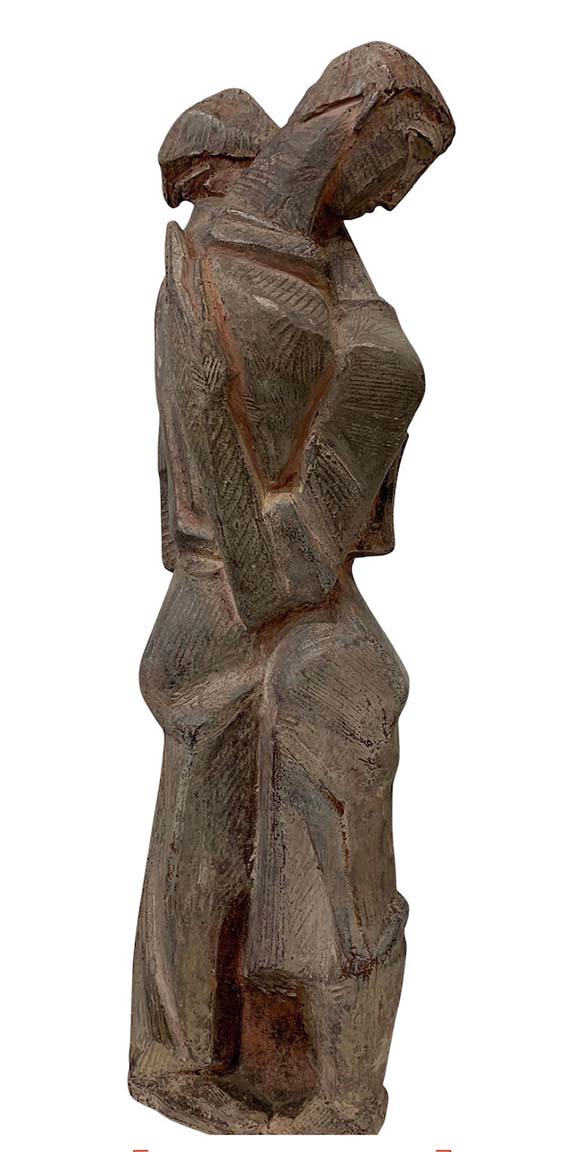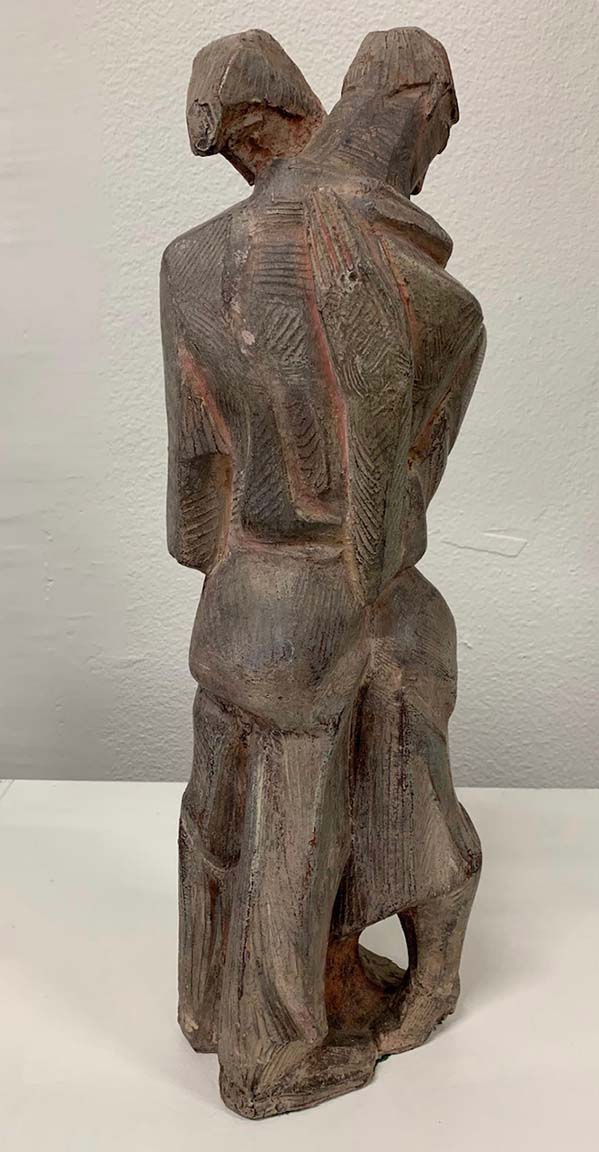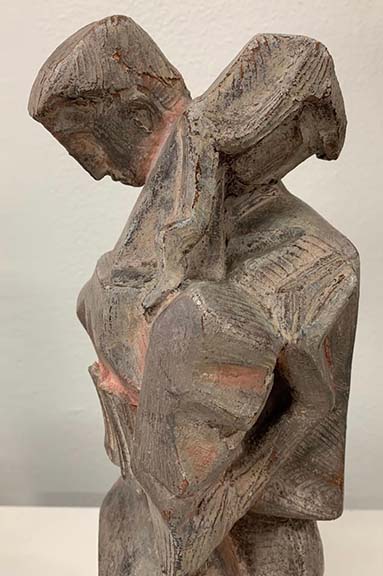



ALBERT WEIN
"THE COUPLE"
TERRACOTTA, SIGNED ON LABEL
AMERICAN, C.1950
22 INCHES

The following biography is from Mark H. Yellen, grandson of the artist: Albert Wein was born in 1915 in New York City. He studied at the Maryland In the 1930's, he worked for the WPA (Work's Project Administration) and in 1946, won the Prix de Rome, a distinguished award which allows artists to study at the American Academy in Rome. While Wein studied in Europe, he became increasingly inspired by the classical art of Italy. After returning to the United States, Wein received the Tiffany award for the sculpture "Demeter." In addition, "Phyrne before the Judges" was chosen to be placed at the Brookgreen Gardens in South Carolina. Both of these sculptures were designed while Wein was at the American Academy Later in the 1950s and 60s, Wein followed the trend towards abstraction but returned to figurative work in the 1970s. At that time he received a commission for the Libby Dam relief (1973), the largest granite relief in the United States. While his abstract works are well received, Wein felt that he had more to express by returning to figurative work, and was able to incorporate the formal design qualities that exploring pure abstraction for nearly twenty years had given him. Wein received almost every award possible for a figurative sculptor. In 1989, Born in New York in 1915 Albert Wein was the only son of an accomplished woman artist. This early influence had a profound effect on the creative course that the then young Wein would follow. When Albert Wein was twelve years old, Elsa Wein, a "studio" mother enrolled the two of them into the Maryland Institute, a school that adhered to a curriculum of academic based Classicism. These early influences in the classical tradition formed an impression that would last him the rest of his artistic career. In fact, Albert Wein was once quoted as saying that the main thrust of his work was "to modernize and stylize the classical tradition". The 1929 Stock Market crash put an end to his studies at the institute and caused the family to return to New York. While attending high school in the Bronx Wein registered at the National Academy of Design taking up study under the well-known painter Ivan Olinsky. By 1932, Wein enrolled in classes at the Beaux-Arts institute in New York where he expanded upon his academic education in sculpture while studying under some of the most prominent practitioners in their field. Wein's inclination toward modernization and stylistic composition in his work was made manifest when he decided to enroll in Hans Hofmann's painting class. Hofmann was regarded as one of the most respected leaders in the forefront of modernism. It was around this time that Wein sculpted "Adam," an early powerful modernist work that revealed what would become his signature stylization of classical tradition. In 1934 he took a pay-cut to join the W.P.A. during which time he was able to produce many fine works for both commission and competition. Among the many honors and awards bestowed upon Albert Wein during his illustrious career included those of the coveted Prix de Rome, the highest award in art, likened to that of the Nobel Prize in literature, the Tiffany Foundation Fellowship, the Rockefeller Foundation grant for study and more. He also was included in the "watershed" exhibition American Sculpture, 1951 at the Metropolitan Museum of Art. In 1979 Wein was elected a full Academician of the National Academy of Design, the highest honor an American artist can receive. During his prodigious career he won every major prize given at exhibitions at the National Sculpture Society and the National Academy of Design. Some of his important commissions include those for the Brookgreen Gardens, (the world's largest outdoor Sculpture Garden, Steuben Glass Co., Bronx Zoo, Franklin Mint, and the "Libby Dam" bas-relief to name just a few. The latter work, Wein's Libby Dam project, was the largest granite bas-relief ever created, weighing some 75 tons and taking several years to complete. This work "has been likened by critics to other sculptures in the U.S. grand tradition such as Daniel Chester French's seated figure of Abraham Lincoln in Washington, Gutzon Borglum's Mount Rushmore, and Paul Manship's gilded bronze statue of Prometheus in Rockefeller Center Plaza". Wein's modernistic approach is also manifest in his paintings and related works. He approached painting much the same way he did sculpture, from a sound academic based foundation that gave him the legitimacy and freedom to express his modernistic views. His paintings have been widely exhibited and have gained him much notoriety, with critics lauding his ability to achieved a balance between the extremes of Classicism and Modernism. His sound foundation of academic excellence provided the basis for his stylized, modernistic approach. Wein Felt that "every good work of art is a good abstract composition" or could at least be represented by one. That the subject, devoid of details and pared down to only what is necessary to convey the "essence" of the composition is what really mattered in an artistic work. Albert Wein passed away in March of 1991. He left behind a legacy of works that express his goal of forging a union between centuries of artistic styles.
|